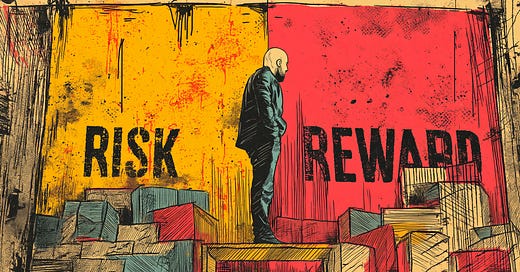Issue #28: How to Make Money in the Market Even If You’re Wrong 80% of the Time
How a few big wins can make losses irrelevant—and why risk-reward is everything in investing and trading.
Reading time: 3 minutes
You can have the best setup in the world.
You can stack technical indicators like a Lego tower, quote Warren Buffett till your jaw falls off, and spend 100 hours on due diligence. None of it will save you if your risk-reward ratio is trash.
You can have an 80% success rate and still lose money. All it takes is one oversized loss to wipe out everything you made. Most people don't realize how fragile they are until it's too late.
But being wrong is part of the game. You don’t get to skip it. You don’t get to avoid it with more research or more conviction. But you can control it.
Here’s how.
The Table Every Investor Should Tattoo on Their Brain
The risk and reward columns show you how much you’re risking compared to how much you expect to make. A 1:3 ratio means you're risking $1 to try and make $3. A 2:1 means you’re risking $2 to make $1, which is worse.
The third column tells you the break-even win rate. That’s the minimum percentage of successful outcomes you need to avoid losing money. If your ratio is 1:1, you need to win at least half the time to break even. If your ratio is 1:3, you only need to be right 1 out of every 4 times.
To put it simply, the higher your potential reward relative to risk, the lower your required accuracy. You can be wrong more often than not and still come out with a profit. And the reverse is also true. If you're always going for small, safe gains while risking a lot to get them, you're going to need to be right most of the time just to survive. That’s how traders blow up, and investors underperform.
Let’s look at an example.
You invest $1,000 into 10 companies, putting $100 into each. 8 of them could fail completely, and you’d be down $800. But if the other two return 5x, that’s $500 each, or $1,000 total. Just like that, you’re breakeven.
Of course, the goal isn't to fail 80% of the time. The point is to position yourself where the upside is large enough to pay for the losers.
I’ve said this more than once in previous issues: you still do your homework. You research the company inside and out. You don’t need an economics degree for that. Most of you already use products or services from great businesses every day. You know what’s good and what’s garbage.
The only thing left is to sit down and look at the numbers. Check the balance sheet, the income statement, the cash flow, etc. It’s not complicated. If you can read your bank app, you can figure out whether a company has more debt than cash or if it’s burning through money like the American government.
So, back to the original example.
You put $1,000 into ten companies. Thanks to your outstanding research, only 4 end up missing the mark. Each drops around 70%, and your $100*4 = $400 turns into $30*4 = $120.
But the other six deliver.
One returns 3x: $300
Another gives you 5x: $500
One goes 4x: $400
And the last three become 8-baggers: $800, $800, and $800
That’s $3,600 from the six that worked. Add back the $120 from the losing four, and your total comes to $3,720.
You started with $1,000, and you have more than tripled it.
The more right you are about one particular stock, the more wrong you’re allowed to be about the others. Outsized winners don’t just offset losses—they render them irrelevant.
— Toghrul Aliyev
Thank you so much for reading! See you next week.




